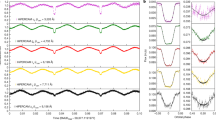Abstract
The aim of this paper has been to study the neutral helium triplet emission lines identified in the spectrum of the envelope of Nova Delphini. By comparing the observed flux of the neutral helium lines with that calculated theoretically by Robbins, we find that the optical thickness in the center of the line λ 3889 is of the order of 21.50 for summer 1969. The optical thickness obtained by this method is here denoted τtran(λ3889).
On the other hand, we obtain the number of neutral helium atoms in the 23S state [N(23S)] by considering the equilibrium between the mechanisms that populate and depopulate this state. We then find that the depopulation by photoionization due to the radiation of Lyα (Hi), transitions to the 21S, 21p and 23p states by electron collision, photoionization due to the continuum radiation of the central star, are 82.70%, 13.20%, 2.40%, 0.90% and 0.80% respectively. We find that the mechanism of the photoionization by Lyα is the dominant mechanism of depopulation of 23S state. We calculated τ(λ 3889) of the order of 82.37, fromN(23S), obtained in the preceding paragraph. The optical thickness obtained by this method is here denoted τbal(λ3889).
The difference between τtran(λ3889) and τbal(λ3889) is very large and it cannot be attributed to calculation errors. We have considered all the mechanisms that can depopulate the 23S state, so we then conclude that the difference between τtran(λ3889) and τbal(λ3889) is due to the heterogeneity of the envelope of the Nova, already found by us in our previous study of the profiles of the permitted and forbidden lines. Finally, we find from this study a ‘filling factor’ of the order of 0.30.
Similar content being viewed by others
Bibliographie
Andrillat, Y. and Houziaux, L.: 1970,Astrophys. Space Sci. 9, 410.
Burgess, B. and Seaton, M. J.: 1960,Monthly Notices Roy. Astron. Soc. 121, 471.
Capriotti, E. R.: 1967a,Astrophys. J. 150, 79.
Capriotti, E. R.: 1967b,Astrophys. J. 150, 95.
Darke, G. W. F. and Robbins, R. R.: 1972,Astrophys. J. 171, 55.
Gabriel, A. H. and Heddle, D. W. O.: 1960,Proc. Roy. Soc. London Ser. A 258, 124.
Harman, R. J. and Seaton, M. J.: 1966,Monthly Notices Roy. Astron. Soc. 132, 15.
Malakpur, I.: 1973a,Astron. Astrophys. 24, 125.
Malakpur, I.: 1973b,Astron. Astrophys. 28, 393.
Malakpur, I.: 1974,Astrophys. Space Sci. 27, 467.
Malakpur, I.: 1976,Astrophys. Space Sci. 47, 3.
Mathis, J. S.: 1957,Astrophys. J. 125, 318.
Pottasch, S. R.: 1962,Astrophys. J. 135, 385.
Robbins, R. R.: 1968,Astrophys. J. 151, 511.
Seaton, M. J.: 1968, in D. J. Osterbrock and C. R. O'Dell (eds.), ‘Planetary Nebulae’,IAU Symp. 34, 129.
Author information
Authors and Affiliations
Rights and permissions
About this article
Cite this article
Malakpur, I. Les raies du triplet de l'helium de la Nova Delphini 1967. Astrophys Space Sci 47, 17–24 (1977). https://doi.org/10.1007/BF00651354
Received:
Issue Date:
DOI: https://doi.org/10.1007/BF00651354




